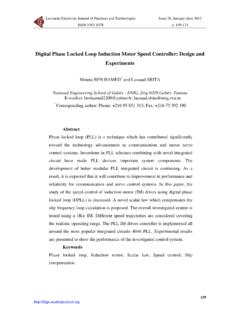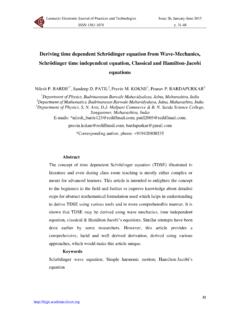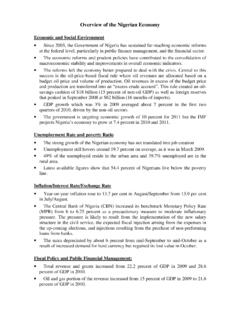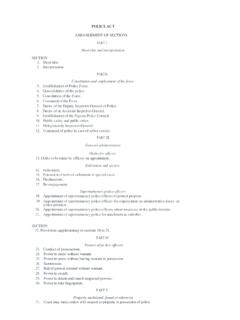Transcription of Determination of appropriate mix ratios for concrete ...
1 Leonardo Electronic Journal of Practices and Technologies ISSN 1583-1078 Issue 26, January-June 2015 p. 79-88 79 Determination of appropriate mix ratios for concrete grades using nigerian Portland-limestone grades and Kazeem Kayode ADEWOLE*, Wasiu Olabanji AJAGBE, Idris Ademola ARASI Civil Engineering Department, University of Ibadan, Ibadan, Nigeria E-mails: * Corresponding author, phone: +2347083389335 Abstract The construction of buildings by incompetent craftsmen and the use of low quality building materials, including low quality concrete have been identified in the literature as two of the major reasons for the incessant collapse of building in Nigeria.
2 The roadside craftsmen/artisans usually/generally construct buildings using 1:2:4 cement-fine aggregate-large aggregate mix ratio irrespective of the cement strength class. In this paper, the investigation conducted to determine the appropriate concrete mix ratios required to produce Class 20/25 and Class 25/30 concretes commonly used for design of building structural members using the Portland-limestone cement grades and that are available in the nigerian open market is presented. Investigation revealed that the cube compressive strength of 1:2:4 concrete produced with Portland-limestone cement grade is less than the minimum 25 MPa required for concrete Class 20/25 and a richer 1 :3 concrete produced with Portland-limestone cement grade may be needed to produce concrete Class 20/25.
3 Investigation also revealed that Portland-limestone cement grade may not be suitable for the production of concrete class 25/30 with cube compressive strength of 30 MPa as the cube compressive strength of 1:1:2 concrete produced with Portland-limestone cement grade may not attain 30 MPa. concrete strength classes 20/25 and class 25/30 can be produced with Portland-limestone cement grade using Determination of appropriate mix ratios for concrete grades .. Kazeem ADEWOLE, Wasiu O. AJAGBE, Idris A. ARASI 80 1:2:4 and 1 :3 mix ratios respectively. To produce concrete with strength class C20/25 which is the minimum concrete strength class recommended for the construction of the load-bearing building structural members using the 1:2:4 mix ratio, Portland-limestone cement grade is required.
4 Keywords Cement grades, concrete grade, Compressive strength, Portland-limestone cement Introduction In the nigerian urban areas, concrete is widely used for the construction of building structural elements [1]. With the exception of buildings owned by the nigerian and foreign governments, corporate organisations such as banks and industries, educated and wealthy individuals, which are designed and constructed by professionals, all other buildings are constructed by roadside craftsmen. These incompetent roadside craftsmen do not carry out any quality assurance tests on the concrete they use for building construction [1].
5 Since most buildings in Nigeria are owned by common individuals who cannot afford to engage the qualified professionals for the construction of their buildings, most building (conservatively about 70%) in Nigeria are constructed by the roadside craftsmen. These roadside craftsmen construct building ranging from one to three/four storeys. The incessant collapse of building is a common occurrence in Nigeria. A survey conducted by [1] revealed that building experts have identified the use of low quality building materials, the use of incompetent artisans/craftsmen and lack of supervision of building construction works by qualified professionals as the main three reasons for the incessant collapse of building in Nigeria.
6 The concrete production, placement and other activities involved in concreting used for the construction of most buildings in Nigeria are done by the roadside bricklayers/masons without the supervision by the qualified professionals. This explains why the incessant collapse of buildings is more common in building construction works owned by individuals that are constructed by the roadside craftsmen. Unlike in the buildings constructed by the professionals, in which, trial mixes to obtain the appropriate mix ratios to achieve the required concrete grades/strength class and Leonardo Electronic Journal of Practices and Technologies ISSN 1583-1078 Issue 26, January-June 2015 p.
7 79-88 81 concrete quality assurance tests are conducted, the roadside craftsmen neither conduct any trial mix nor any quality assurance tests on concrete . They generally use 1:2:4 cement-fine aggregate-coarse aggregate mix ratio irrespective of the strength class/grade of the cement as they are unaware of the presence of different cement grades in Nigeria and their effects on concrete strength. The roadside bricklayers have been using 1:2:4 mix ratio as a rule of thumb before the introduction of the different cement strength classes into the nigerian open market and are still using the same 1:2:4 concrete for the construction of the load-bearing building structural members till date irrespective of the cement strength classes.
8 It is not only the roadside bricklayers that are unaware of the presence of different cement grades/strength classes in Nigeria, many of the professionals, academics and researchers in Nigeria are also unaware of the presence of cement of different grades/strength classes in Nigeria. This explains why the authors of the published work on concrete in Nigeria such as [2 - 11] amongst others did not indicate the grade/strength class of the cement they used for their researches. Nigerians generally are only aware of the different cement brand names and they buy and use cement based on brand names rather than cement grades/strength classes.
9 In the nigerian open market, the two cement grades/strength classes that are available and which are used for building construction are cement grade and cement grade Generally, cement grade represents a higher strength cement than cement grade In addition to the lack of awareness of the different cement grades in Nigeria, most nigerian craftsmen and professional engineers as well as academics and researchers still believe that the bagged Portland-limestone cement, the only cement type in the nigerian open market is the same Ordinary Portland Cement (OPC) they used in the past.
10 They are not aware that the OPC, which was the only cement type allowed to be produced in Nigeria by the old nigerian industrial standards for cement: NIS 11: 1974 [12] and NIS 439:2000 [13] no longer exist in the bagged form in Nigeria. In Nigeria, OPC is only produced in bulk on request by the big construction companies handling big government projects. The lack of awareness of the fact that the bagged cement in the nigerian open market is Portland-limestone cement explains why the ten nigerian authors cited earlier amongst others indicated that they used OPC in their research instead of Portland-limestone cement they bought from the nigerian open market.








